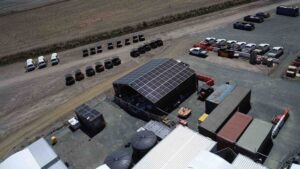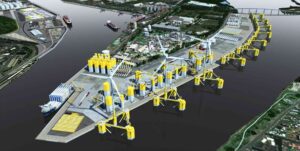Revised plans have been unveiled for a more than 100 kilometre transmission line that would link two new wind farms with a combined capacity of between 600-1000MW with the grid in Tasmania’s north-west.
UPC Renewables, which is behind the two proposed wind farms at Tasmania’s Robbins Island and Jim’s Plain, released the preliminary route for a 115km transmission line late last week, opening it for community feedback a second time.
The two wind farms – themselves controversial for their size and location, and for the high profile opposition they have attracted, including from Greens founder Bob Brown – would need the new power link, due to the existing line from Smithton to Burnie already being “overcommitted.”
Original draft plans to install a 170km transmission line from Sheffield to Robbins Islands did not go down well with the community when released in June this year.
As we reported at the time, landowners from around 17 private properties were said to have received letters from UPC saying compulsory land acquisition of part of their property could be on the cards if an agreement could not be reached.
UPC chief operating officer David Pollington said last week that the current design – involving 50 metre power poles placed about 400 metres apart – would wind its way from Robbins Island past Jim’s Plain and though to Hampshire (south of Burnie).
The company says the new pathway had been charted as much as possible to avoid areas of high environmental and heritage significance; minimise the impact on private landowners by preferencing crown land and commercial land wherever possible; and minimise the impact on visual amenity.
To this end, it would take in about 11.5km of private land, 6km of corporate dairies, 8.5km of crown land, and 90 kilometres of corporate forest, UPC said. A 60 metre easement would follow the lines, restricting vegetation, permanent structures and machinery of a certain height from passing underneath.
“One of the things that we did … was look to get minimal impact to private landowners, minimising impact to agriculture and to steer away from environmentally sensitive areas,” Pollington told The Burnie Advocate.
But, he added, there was “a lot of work to go.”
“We have consulted with all the directly impacted landowners along the way and got to a position that they are in principal happy with,” he said.
“The preliminary route plus the owners’ in principle agreement will allows us to access the land and determine if it’s okay to go there.”
Construction of the new line is also expected to be tied in with grid upgrades planned by TasNetworks for between Burnie, Hampshire, Sheffield and Palmerston.
The Nietta Action Group – a community group that formed in May this year in opposition to UPC’s original transmission line plans – noted the release of the new proposal on its Facebook page.
The post said UPC had “learnt from the disastrous release of the first proposed route” and done its homework this time around, but called on members to ask questions, demand changes and insist on the adoption of mitigation measures.
The group’s post also suggested that UPC’s promise of compensation for loss of land associated with the transmission line’s footprint was not broad enough.
“What about the other losses which landholders (directly impacted and adjoining), other businesses and the entire community stand to bear, such as impacts on investment security, livelihoods, sense of place and wellbeing? What about the environmental impacts? How will those be mitigated, compensated and off-set?,” it asked.
A comment on the post has also pointed out that – according to an interactive map put together by UPC – the UPC part of the transmission line appears to end at Hampshire.
“They state it will then connect to the planned ‘North West Transmission Network’, which will be built by TasNetworks, and will connect Hampshire to Staverton.
“So the TasNetworks portion of the line is the critical part (as far as Wilmot and surrounds is concerned). I could not find any information on what route the Hampshire to Staverton line will follow,” the comment said.










